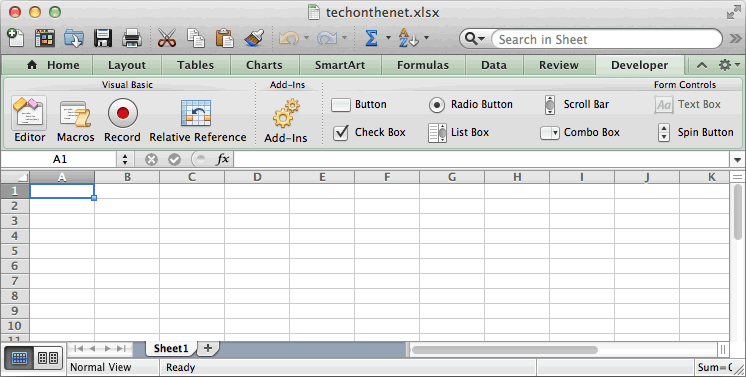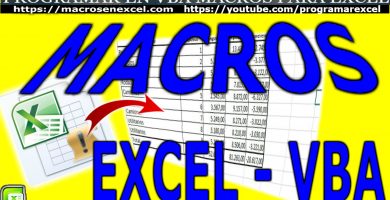You can access the VBA environment in Excel 2011 for Mac by opening the Visual Basic editor. First, be sure that the Developer tab is visible in the toolbar in Excel. The Developer tab is the toolbar that has the buttons to open the VBA editor and create Form Controls like buttons, checkboxes, etc. Microsoft just released an update to the VB Editor for the Mac 2016 version of Excel. New features include: - Edit and debugging toolbars. Updated Project. Or ctrl ESC keys do not function exactly like on the PC. They do not break to the debugger on a modal dialog box. Use ESC ESC (Press the ESC twice) to bring up a dialog that allows you to enter the debugger at the location in code of the dialog box display. Tested in Excel VBA 2011. Visual Basic VBA Barcode Macro & Functions Tutorial for Microsoft Office Excel, Access & Word on Windows or Mac. IDAutomation VBA Barcode Functions and Macros allow easy generation of barcodes in Microsoft Office Suite applications such as Excel, Word and Access on both Windows® and Mac operating systems, compatible with Excel 2003 and greater in Windows and Excel 2011 and greater on Mac.
-->Utilisez des macros et des compléments VBA que vous avez développés pour Office pour Windows avec Office pour Mac.Use VBA add-ins and macros that you developed for Office for Windows with Office for Mac.
S’applique à : Excel pour Mac | PowerPoint pour Mac | Word pour Mac | Office 2016 pour MacApplies to: Excel for Mac | PowerPoint for Mac | Word for Mac | Office 2016 for Mac
Si vous créez des macros pour Office pour Mac, vous pouvez utiliser la plupart des objets disponibles dans VBA pour Office.If you are authoring Macros for Office for Mac, you can use most of the same objects that are available in VBA for Office.Pour plus d’informations sur VBA pour Excel, PowerPoint et Word, consultez les rubriques suivantes :For information about VBA for Excel, PowerPoint, and Word, see the following:

Notes
Outlook pour Mac et OneNote pour Mac ne prennent pas en charge VBA.Outlook for Mac and OneNote for Mac do not support VBA.
Le mode bac à sable (sandbox) pour Office 2016 pour MacOffice 2016 for Mac is sandboxed
Contrairement aux autres versions des applications Office qui prennent en charge VBA, les applications Office 2016 pour Mac sont en mode bac à sable.Unlike other versions of Office apps that support VBA, Office 2016 for Mac apps are sandboxed.
Le sandboxage limite les applications d’accès aux ressources en dehors du conteneur d’application.Sandboxing restricts the apps from accessing resources outside the app container.Cela affecte les compléments ou macros qui impliquent l’accès aux fichiers ou la communication entre les processus.This affects any add-ins or macros that involve file access or communication across processes.Vous pouvez réduire les effets du bac à sable à l’aide des nouvelles commandes décrites dans la section suivante.You can minimize the effects of sandboxing by using the new commands described in the following section.
Création d’un programme d’installation ou ajout de contenu utilisateurCreating an installer or putting user content
Pour obtenir des instructions sur la création d’un programme d’installation pour votre complément, reportez-vous à l’article suivant : Nstalling user content in Office 2016 for MacFor instructions on creating an installer for your add-in, please refer to the article here: nstalling User Content in Office 2016 for Mac
Nouvelles commandes VBA pour Office 2016 pour MacNew VBA commands for Office 2016 for Mac
Les commandes VBA suivantes sont nouvelles et propres à Office 2016 pour Mac.The following VBA commands are new and unique to Office 2016 for Mac.
| CommandCommand | Utiliser pourUse to |
|---|---|
| GrantAccessToMultipleFilesGrantAccessToMultipleFiles | Demander l’autorisation d’un utilisateur pour accéder à plusieurs fichiers à la fois.Request a user's permission to access multiple files at once. |
| AppleScriptTaskAppleScriptTask | Appeler des scripts AppleScript externes à partir de VB.Call external AppleScript scripts from VB. |
| MAC_OFFICE_VERSIONMAC_OFFICE_VERSION | IFDEF entre les différentes versions de Mac Office au moment de la compilation.IFDEF between different Mac Office versions at compile time. |

Personnalisation du ruban dans Office pour MacRibbon customization in Office for Mac
Office 2016 pour Mac prend en charge la personnalisation du ruban à l’aide du code XML du ruban.Office 2016 for Mac supports ribbon customization using Ribbon XML.Notez qu’il existe quelques différences au sein de la prise en charge du ruban dans Office 2016 pour Mac et Office pour Windows.Note that there are some differences in ribbon support in Office 2016 for Mac and Office for Windows.
| Fonctionnalité de personnalisation du rubanRibbon customization feature | Office pour WindowsOffice for Windows | Office pour MacOffice for Mac |
|---|---|---|
| Possibilité de personnaliser le ruban à l’aide du code XML du rubanAbility to customize the ribbon using Ribbon XML | AvailableAvailable | AvailableAvailable |
| Prise en charge des compléments basés sur des documentsSupport for document based add-ins | AvailableAvailable | AvailableAvailable |
| Possibilité d’appeler des macros à l’aide de contrôles de ruban personnalisésAbility to invoke Macros using custom ribbon controls | AvailableAvailable | AvailableAvailable |
| Personnalisation des menus personnalisésCustomization of custom menus | AvailableAvailable | AvailableAvailable |
| Possibilité d’inclure et d’appeler les contrôles Office Fluent dans un onglet de ruban personnaliséAbility to include and invoke Office Fluent Controls within a custom ribbon tab | AvailableAvailable | La plupart des identificateurs de contrôle Office Fluent familiers sont compatibles avec Office pour Mac.Most familiar Office Fluent Control Identifiers are compatible with Office for Mac.Certaines peuvent ne pas être disponibles.Some might not be available.Pour les commandes compatibles avec Office 2016 pour Mac, voir idMso compatible avec office 2016 pour Mac.For commands that are compatible with Office 2016 for Mac, see idMSOs compatible with Office 2016 for Mac. |
| Prise en charge des compléments COM qui utilisent des contrôles de ruban personnalisésSupport for COM add-ins that use custom ribbon controls | AvailableAvailable | Office 2016 pour Mac ne prend pas en charge les compléments COM tiers.Office 2016 for Mac doesn't support third-party COM add-ins. |
idMso compatible avec Office 2016 pour MacidMSOs compatible with Office 2016 for Mac
Pour plus d’informations sur les idMso compatibles avec Office 2016 pour Mac, consultez les rubriques suivantes :For information about the idMSOs that are compatible with Office 2016 for Mac, see the following:
Voir aussiSee also
Vba For Macros Excel Tutorial
Assistance et commentairesSupport and feedback
Avez-vous des questions ou des commentaires sur Office VBA ou sur cette documentation ?Have questions or feedback about Office VBA or this documentation?Consultez la rubrique concernant l’assistance pour Office VBA et l’envoi de commentaires afin d’obtenir des instructions pour recevoir une assistance et envoyer vos commentaires.Please see Office VBA support and feedback for guidance about the ways you can receive support and provide feedback.
This Excel tutorial explains how to open the Visual Basic Editor in Excel 2011 for Mac (with screenshots and step-by-step instructions).
See solution in other versions of Excel:
You can access the VBA environment in Excel 2011 for Mac by opening the Visual Basic editor.
First, be sure that the Developer tab is visible in the toolbar in Excel.
The Developer tab is the toolbar that has the buttons to open the VBA editor and create Form Controls like buttons, checkboxes, etc.
To display the Developer tab, click on Preferences under the Excel menu at the top of the screen.
When the Excel Preferences window appears, click on the Ribbon icon in the Sharing and Privacy section.
In the Customize section, check Developer in the list of tabs to show. Then click on the OK button.
Select the Developer tab from the toolbar at the top of the screen. Then click on the Editor option in the Visual Basic group.
Excel Macros And Vba For Beginners
Now the Microsoft Visual Basic editor should appear and you can view your VBA code.